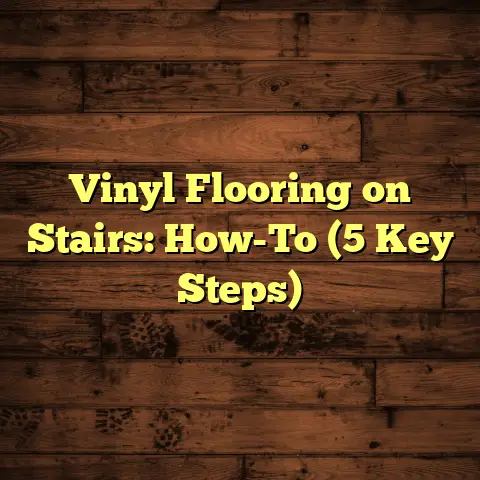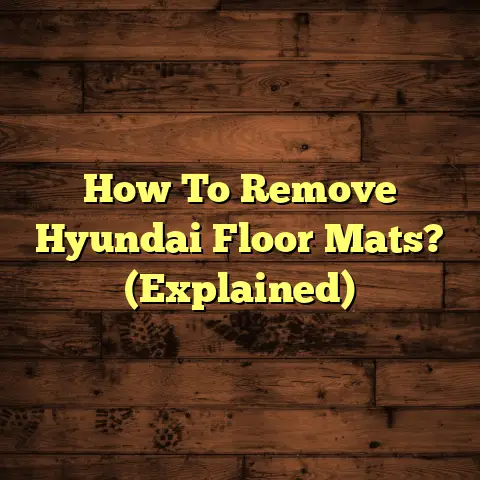How To Stop Washing Machine From Moving On Tile Floor? (Explained)
I often hear people say that a washing machine moving on a tile floor is just something you have to deal with.
But let me tell you, that’s far from the truth!
After years of working as a flooring contractor, I can assure you there are effective ways to stop that pesky movement, and I’m here to share my insights.
Understanding the Issue
When I first encountered clients struggling with their washing machines sliding around, I thought it was simply a matter of poor installation or a bad choice of flooring.
However, I quickly realized that the problem often stemmed from the combination of the machine’s weight, the vibrations during the spin cycle, and the smooth surface of tile flooring.
If you’re dealing with this issue, you’re not alone.
Many homeowners face the same challenge.
So, how do we tackle this?
The Mechanics Behind Washing Machine Movement
Understanding why a washing machine moves can help us find effective solutions.
A typical washing machine can weigh between 150 to 250 pounds when empty, and during operation, especially in the spin cycle, it can vibrate significantly.
Here’s what you should know:
- Vibration Dynamics: The spin cycle creates centrifugal force that pushes outwards.
If the machine isn’t stable, it will literally walk across your floor. - Floor Type: Tile floors are smooth and can be slippery for heavy appliances.
This makes it easier for the machine to slide, especially if it’s not level. - Weight Distribution: An unbalanced load in the washer can exacerbate the problem.
If clothes are bunched up on one side, it can create uneven pressure leading to excessive movement.
Solutions to Stop Your Washing Machine from Moving
1. Check and Level the Machine
One of the first things I do when assessing a washing machine that moves too much is to check if it’s level.
An unlevel machine can cause vibrations that lead to movement across the floor.
- How to Check: Use a level tool—just place it on top of the machine and adjust the feet until it reads perfectly level.
If you don’t have a level, you can use a smartphone app that has leveling features. - Why It Matters: Keeping the washing machine level helps distribute its weight evenly, reducing vibrations during operation.
I recall a project where leveling made all the difference.
A client had an older machine that seemed to dance across the floor with every wash.
After adjusting the feet, it stopped moving altogether!
2. Use Anti-Vibration Pads
In my experience, anti-vibration pads are game-changers.
These pads absorb vibrations and provide a grip that keeps appliances in place.
- Material Matters: Look for pads made from rubber or silicone.
They are effective and durable. - Installation Tip: Simply place them under each foot of your washing machine.
Depending on how much vibration your machine produces, you might want to look into thicker pads designed for heavy-duty use.
I remember installing these pads in a client’s laundry room last summer.
They were amazed at how much quieter and stable their machine became!
3. Secure with a Washing Machine Tray
Another option I’ve found effective is using a washing machine tray or pan.
This is especially useful if you have a front-loading washer.
- Benefits: The tray not only contains any leaks but also adds stability.
- Installation: Position the tray beneath your washing machine and ensure it fits snugly.
I’ve installed trays in several homes where water damage was a concern.
Not only did it keep the machine in place, but it also provided peace of mind against potential leaks.
Keep Your Floor Safe
Tile floors can be prone to scratching or cracking if appliances move excessively.
Here’s what I suggest:
4. Flooring Considerations
While tile is durable, it can still suffer from heavy appliances shifting over time.
- Protective Coatings: Consider applying a protective coating designed for tile floors.
This could be a sealant that adds an extra layer of protection against scratches. - Rug or Mat: Placing a rug or mat underneath can also help minimize friction and protect your flooring.
Just ensure it’s not too thick, as this could throw off your leveling efforts.
In one case, a client had an expensive Italian tile that was starting to show signs of wear from their washing machine.
After implementing protective measures, they saw a significant improvement.
Addressing Noise
Noise can be another issue when your washing machine moves around.
Here are some additional tips:
5. Balance the Load
Sometimes it’s not just about how the machine sits but also how it operates.
- Even Distribution: Make sure to load clothes evenly in the drum.
Avoid overloading or underloading. - Tip: If your washer has an “out-of-balance” indicator, make sure you pay attention to it.
I once had a client who complained about noise more than movement.
After discussing proper loading techniques, they reported back that their machine was much quieter.
Cost Estimation and FloorTally
When it comes to budgeting for any changes, I rely heavily on FloorTally for accurate cost estimations.
- Why It Works for Me: It pulls local material and labor rates, allowing me to give my clients realistic budgets for any flooring work.
- Example: If adding protective mats or anti-vibration pads, I can quickly calculate costs based on current market rates.
Using FloorTally has saved me countless hours and helped establish trust with my clients through transparent pricing.
Maintenance Tips
Once your washing machine is stable, maintaining that stability requires some regular checks:
6. Routine Inspections
Make it a habit to check your washing machine every few months.
- Look for signs of wear on pads or mats.
- Reassess the leveling if you notice any movement.
In one instance, I had a client who neglected these checks and ended up with significant damage to their floor after the pads wore out completely.
Additional Considerations
Sometimes, movement can be tied to other factors outside just the washing machine itself.
7. Assess Your Floor
If your tile is uneven or has been poorly installed, it might be worth looking into repairs.
- Inspection: Check for cracks or uneven spots.
- Repair Options: Depending on severity, you might need to consult with a flooring specialist.
In a recent project, I encountered a home where the tile flooring had settled unevenly over time, causing all sorts of appliance issues.
Correcting the floor made all appliances function properly again!
Exploring Alternative Solutions
Beyond basic adjustments and tools, there are advanced methods I’ve explored in my work as well:
8. Installing Shims
For those machines that just won’t stay put despite leveling efforts, shims can offer extra support.
- Material Choices: Use plastic or wood shims based on what’s available and suitable for your flooring type.
- Placement: Slide shims under the feet of your washing machine at points where additional height is needed to create a level surface.
I’ve used shims successfully in older homes where floors had settled unevenly over decades.
They’re an affordable solution that can really make a difference!
9. Consulting with Professionals
If DIY solutions aren’t cutting it, sometimes it pays to consult with professionals who specialize in appliance installation or flooring.
- Why It Helps: They can identify underlying issues you might not have considered and provide tailored solutions based on years of experience.
I had a client who was frustrated after trying every trick in the book without success.
A professional installer quickly pinpointed an issue with the flooring that was causing all kinds of problems.
Practical Advice for Long-Term Stability
To ensure your washing machine stays put over time:
10. Educate Family Members
Make sure everyone who uses the washing machine understands how to load it properly and recognizes signs of instability.
- Share Knowledge: Teach them about balancing loads and what signs indicate that adjustments may be needed.
I’ve noticed that when family members are informed about proper usage, it significantly reduces appliance problems in many households.
11. Keep an Eye on Vibration Over Time
Over time, even stable machines can start to move due to wear and tear on components like shock absorbers.
- Regular Checks: Every few months, inspect these components for signs of wear.
- Replacement Parts: If they’re worn out, consider replacing them before they lead to larger issues down the road.
In one particular instance, I had a returning client whose washer began moving again after two years.
A quick inspection revealed worn shock absorbers—replacing them fixed the problem right away!
Conclusion
Keeping your washing machine from moving on a tile floor is entirely possible with the right approach.
- Start by leveling your machine.
- Invest in anti-vibration pads and secure your appliance with trays as needed.
- Regular inspections will help ensure everything stays in place.
By taking these steps not only will you protect your flooring investment but you’ll also enhance the performance and longevity of your washing machine.
Have you faced similar issues?
What solutions have worked for you?
I’d love to hear your experiences!





